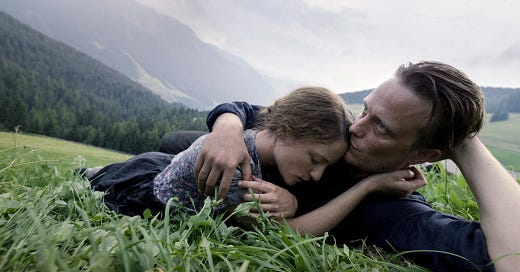100 Movies Every Catholic Should See #29: A Hidden Life (2019)
Written and directed by Terrence Malick
“I thought that we could build our nest high up in the trees. Fly away, like birds-to the mountains.”
What is at the heart of our faith? What defines it? Is it characterized by this wishing to fly away? I would like to contrast these assumptions of “flying away,” as it were, with the ultimate sign of faith, that of sacrifice. Sacrifice is central to the faith; we offer something up every lent, when we receive the sacrament of penance, and at Mass every Sunday.
Bl. Franz Jägerstätter (portrayed by August Diehl) is emblematic of sacrifice in Terrence Malick’s 2019 masterpiece A Hidden Life. Jägerstätter was one of the few men who were executed for being a conscientious objector to the Third Reich during the Second World War. The reason for his conscientious objection? His Catholic faith. Like others who gave up their lives in the name of the word such as St. Maximilian Kolbe and St. Edith Stein, Bl. Franz Jägerstätter opted out of his “nest” above the clouds for a reunification with the word.
This theme of reunification reminds me of certain passages in then Cardinal Joseph Ratzinger’s (Pope Benedict XVI) book ‘In the Beginning…’ A Catholic Understanding of Creation and the Fall. From a synthesis of the book and the film, Jägerstätter, rejects the attempt to naturalize our toil[1], our scattering[2], things that would otherwise be seen as temporary within the fullness of time: things that the Third Reich sought to immortalize and to make ascendant over the transcendent. These vices are exemplified in Jägerstätter’s frequent encounters with the mayor of the town, vices that Ratzinger correctly points out in the book are the very rejection of our being with God, something that Ratzinger writes is what the sabbath is: “In the creation account the sabbath is depicted as the day when the human being participates in God’s freedom, God’s rest, and thus in in God’s peace.”[3]
Malick and his aesthetical way of filming furthers the concept of nature, beauty, leisure, and this place of participation with God. But viewers familiar with Malick’s work know that he prefers the intimate to the wide, the small to the big, because it is only in those intimate moments caught on camera that we can truly explore the character. The way this and his other films are shot place the viewer in the passenger seat; the way his films are shot is how we see ourselves in the world. This is also helped by Malick’s trademark character narration; few directors have mastered this, and it is the perfect filmmaking technique to capture the intimacy of Jägerstätter and his wife, not to mention the film’s other characters (especially the priests and bishops). But what we are ultimately witnessing in this film is prayer, reflection in those meditative narrations.
These meditative narrations are often carried over into conversations that friends and other villagers have with Jägerstätter, conversations held in private out of fear for themselves and their families. The conversations were marked by the same theme: do those bought into the message of the Third Reich know that they do evil? Do Christ’s words from the cross apply to them or not: “They know not what they do”?
What makes Jägerstätter’s life in the film all the more remarkable is his willingness to endure, further, to the very limits of human punishment; occasional physical beatings, but most of all that deprivation of proper time for prayer and his family. As the painter in the church during the film reminds us, “Christ’s life is a demand. The people, they don’t want to be reminded of it; they’ll fight the truth, and they’ll just ignore it. What I do is create sympathy.” It is through all the saints and the blesseds that we are reminded of the aspect of our faith: sacrifice. And it is in this film that Malick fully expresses this very Catholic conception of sacrifice, something that we should all, especially Catholics, should seek to emulate.
Bl. Franz Jägerstätter, Pray for us!
[1] Genesis 3:16-17
[2] Genesis 11:8-9
[3] Ratzinger, Joseph (Benedict XVI), ‘In the Beginning…’ A Catholic Understanding of Creation and the Fall (Huntington, Indiana: Our Sunday Visitor, 1990), 44.







I saw A Hidden Life in theaters with a friend from church. Since the only theater where it was showing was some distance away and neither of us drive, we had another friend from church take us there. Unfortunately, she was busy so she couldn't watch the film with us and drive us back. We could take public transportation but that's hard for my friend, who has limited mobility. We watched the movie, which we enjoyed very much, and afterwards we found out that one of the priests from our church was there too. He happily drove us back as we all talked about the film. That's not a major miracle, of course, but I do believe God was behind it and I wanted to share that story.
I loved this movie. So glad to see it included.